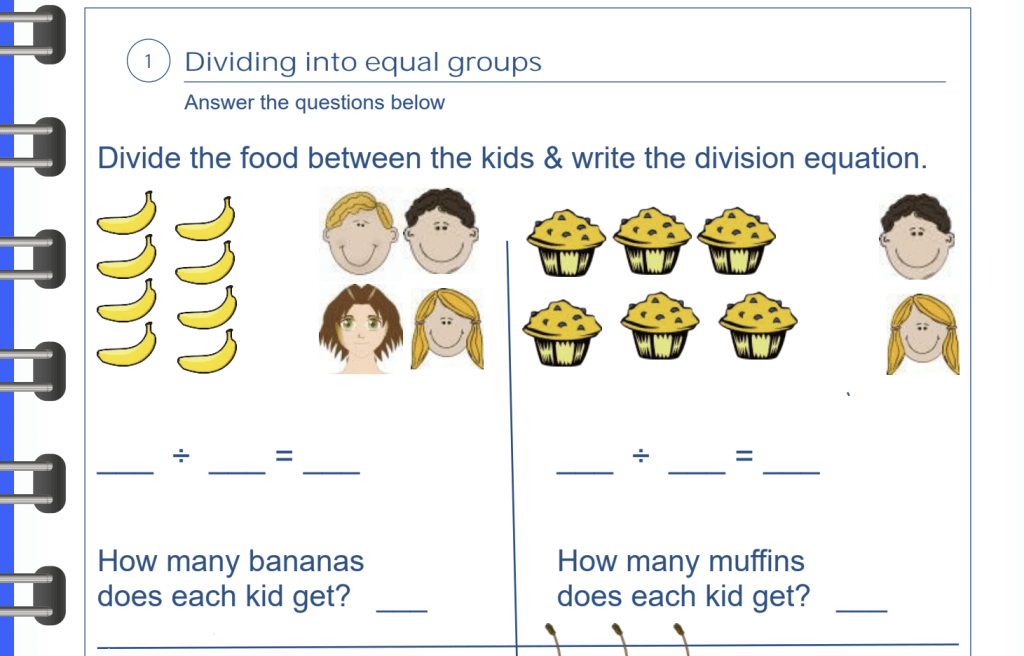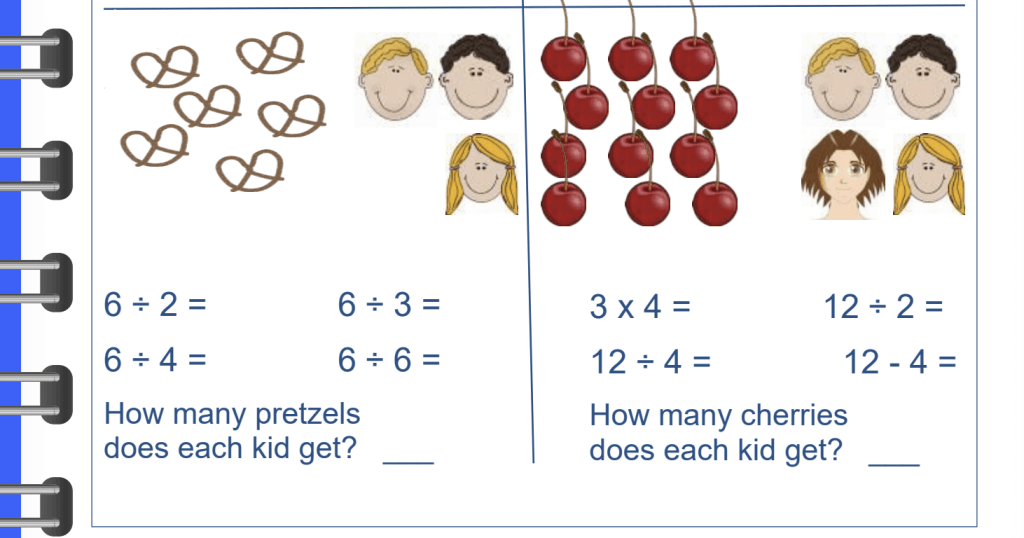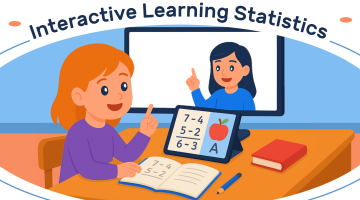How to Teach Kids Division?
reviewed by Jessica Kaminski
Updated on November 17, 2025
Is your child struggling with learning division? Using my expertise as a math teacher, I’ve gathered 12 different approaches to teaching division as a parent that are so diverse that they guarantee to work with all types of learners. But remember that sometimes the best way to teach division requires some external help, such as 1:1 tutoring, which Brighterly offers.
Key points
- There are a lot of effective ways to teach division, from equal sharing and connecting with multiplication, to column division and word problems. In all cases, make sure your child understands the concept rather than simply memorizing numbers.
- Division worksheets provide much-needed practice to apply knowledge and improve skills.
- Combining any method with highly personalized tutoring – such as Brighterly math and reading platform – speeds up learning, eliminates stress, and boosts outcomes.
How to teach division with Brighterly?
Brighterly offers 1:1, personalized tutoring that helps kids learn how to divide as well as other basic and advanced math concepts. The Brighterly approach combines theoretical studying with practical, real-life examples, gamification, and fun, and is tailored to the individual needs of each child.
Brighterly features that make learning division for kids so effective
Customized math program
Brighterly math classes are STEM-based and comply with the US state standards in the subject, so that both children attending public schools and those who prefer various types of homeschooling can benefit. Meanwhile, the Brighterly award-winning curriculum gets personalized to the grade, level, needs, and goals of each student after a careful assessment of their current status.
To boost effectiveness, math lessons are delivered 1:1, in real time by professional math teachers. The positive impact of the combination of all these factors becomes obvious in parents’ reviews of Brighterly on Trustpilot.

Professional, understanding math tutors
A second key feature that makes Brighterly so great at teaching division to kids is the quality of tutors. All of them have a Bachelor’s or Master’s degree in math and 5 or more years of experience in teaching or tutoring the subject. Additionally, math tutors are trained pedagogists, so they can work with children with different learning needs, including students with neurodivergent issues.
What’s more, Brighterly math teachers are good people who are compassionate and caring, and this clearly shows during tutoring sessions. They take the time to understand each child’s requirements and preferences and adjust their style in real time. They are also fun, incorporating math songs and math jokes for kids in their teaching.
Free interactive worksheets
Finally, the Brighterly platform provides free math worksheets that don’t even require an account. What I like about these worksheets is that they are organized by grade level and concept, making it easier to locate the right source to exercise new skills gained at school or during tutoring.
Moreover, they can be easily printed, so your child doesn’t need to spend too much time in front of the screen. The questions not only tackle real-world examples to make division for beginners more tangible but also use nice illustrations and easy wording to be fun and engaging.
Brighterly pricing is affordable as it starts at only $17.30/lesson with a 12-month plan covering 3 lessons/week.
If you’re not sure whether your child needs specialized help in learning division, you can use the free diagnostic math tests offered by Brighterly to check their level and decide.
When do kids begin to learn division?
In the US educational system, children get a formal intro to division in grade 3, after being taught multiplication in grade 2. However, in reality, introducing division starts much earlier, through basic real-life examples. For example, a kid might run into a situation where they need to share toys or cookies with friends, which eventually boils down to dividing them.
As a math teacher, I’d say it’s a good idea to start slowly bringing up division concepts to your child from the age of 3 and up. At the end of the day, when do kids learn division depends largely on when their parents start working on it. The more your child runs into simple division problems early in life, the easier it will be to officially teach them how to divide once the time comes.
How to teach simple division to 1st and 2nd-grade students?
The best way for teaching division to grade 2 and earlier is through real-world examples and entertaining activities. For instance, you can give them 10 balls and ask them to distribute them equally among their teddy bears. This shows how math and division work in real life and why it’s important to know them.
If you are looking for another strategy on how to teach division to grade 2, try using math songs for kids. The Division Song for Kids always proves effective for young learners by turning division into subtracting, grouping, and sharing – concepts that 1st and 2nd graders are familiar with.
You can also teach division to grade 2 with worksheets. As I mentioned above, Brighterly has a rich collection of grade-appropriate worksheets full of pictures, which makes them ideal for this age group.
How to explain division to a child? [from 3rd grade on]
The best way to explain division to a child in grade 3 is to use patterns. To do this, you first need to make sure that your kid has a strong foundation in multiplication and then present division as the opposite of multiplication. Soon, your child will start noticing that 3 x 4 = 12, while 12 / 3 = 4 and 12 / 4 = 3.
If you decide to teach division to grade 3 with worksheets (long division, too), you’ll see that they frequently use this strategy.
When it comes to teaching division to grade 4, try the equal sharing approach. Use manipulatives, such as blocks or pencils, that your kid needs to share equally between family members or friends. Gradually move to division vocabulary, including dividend, divisor, and quotient. Whether your child goes to school or is getting homeschooled, try to teach division to grade 4 with worksheets. This allows you to provide them with as many practice problems as they need to build skills and confidence.
12 ways to teach division
- Explain it as sharing and equal groups
- Teach division vocabulary to build understanding
- Connect division to multiplication facts
- No-remainder practice with arrays
- Teach division with remainders
- Divide decimals
- Use word problems
- Help kids check division using multiplication
- Try column division for beginners
- Introduce division by playing games
- Teaching division for kids by cooking
- Learn division with visualization
#1 Best way to teach division: Explain it as sharing and equal groups
One of the best ways to teach easy division for grade 2 and up is to use equal sharing. This simply means to show that to divide means to split evenly. This strategy helps young learners understand the core logic of division and its purpose, which facilitates the whole process onward.
How to do this in practice?
Use everyday examples. For example, give your child 4 apples and make them share them equally with their brother or sister.

Slowly make problems harder by increasing the number of objects to be shared and the number of people to be shared among. Your kid will grasp the concept and be able to handle more and more complicated division examples.
#2 Teach division vocabulary to build understanding
To support your child’s work at school, it’s important to be explaining division with the proper division vocabulary as its usage will be required in the classroom. Even if your child is still very young, don’t worry about using words like dividend, divisor, quotient, and remainder. I’m sure you’ve heard that kids’ brains are like sponges, so they’ll be able to absorb all new terminology in no time.
For instance, don’t ask them how much 15 divided by 3 is. Instead, ask them how much the quotient is if the dividend is 15 and the divisor is 3. This will show your child that you take them seriously, as a mature equal, which will enhance their self-esteem, and this always makes learning more efficient.
#3 Division for kids: Connect division to multiplication facts
Another easy way to learn division at any age is to relate it to a concept that you already know, in this case, multiplication. Once your kid has solidified their knowledge of multiplication facts, turning them into division facts will be a piece of cake.
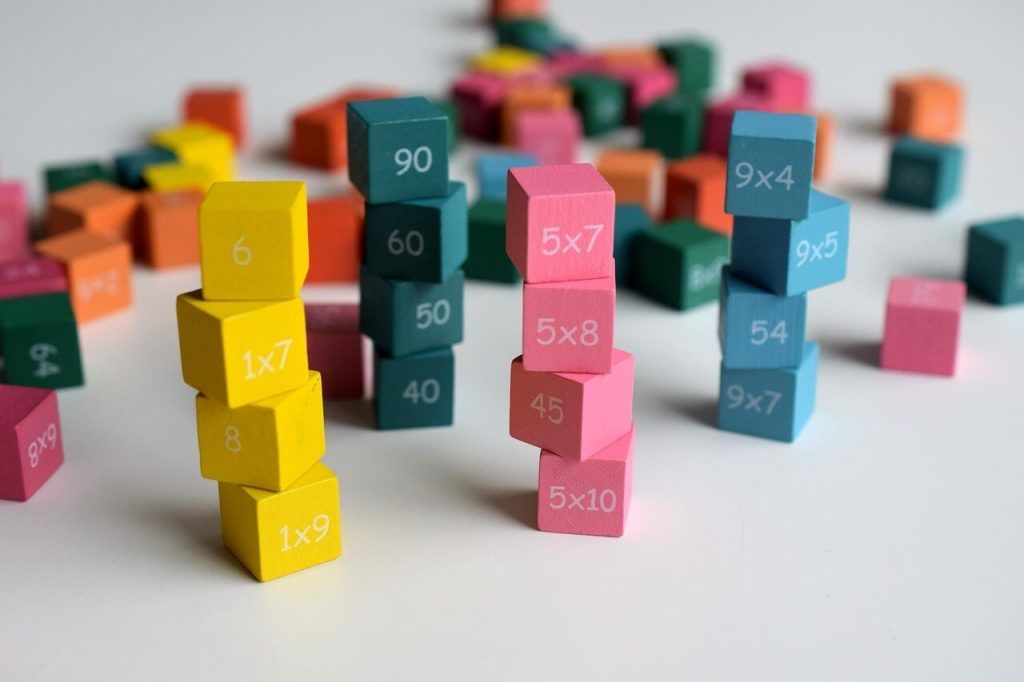
From the multiplication table, a 2nd grade student already knows that 6 x 7 = 42. Now it’s just a matter of explaining that division reverses multiplication, so 42 divided by 6 equals 7. As soon as they conceptualize this idea and know how to multiply, they will be able to divide any number from the multiplication table with no further memorization.
#4 Easy way to explain division: No-remainder practice with arrays
While your child is still learning how to divide without a remainder, you can try the arrays approach. This fancy name boils down to a very basic concept that many students find easy to comprehend and take advantage of.
All you need to do is to show your child how to present division into a grid on a piece of paper, where the dividend equals the total number of cells in the table, the divisor equals the number of rows, and the quotient equals the number of columns. This is a great way to visualize the abstract concept, so it’s particularly good for visual learners.
#5 Teaching division with remainders
Your division teaching methods need to become more sophisticated as your child advances in school grades. As soon as division with a remainder is introduced, you need to adapt your approach.
How to do this?
Start with small numbers and make sure that your child is understanding division with a remainder as an idea. Using bananas, balls, or any other item available at home, show them that sometimes when you try to share things equally between a few people or groups, there are a few left that you can’t distribute unless you cut them.
Take 5 cups to divide between the family members (let’s assume you are 4 in the family). After giving 1 cup to everyone, your kid will clearly see that 1 is left, so this is the remainder.
#6 Best way to teach division: Dividing decimals
Once you move beyond how to learn division for beginners, you’ll also run into dividing decimals, or numbers with a decimal point (not integers). Before you get started, make sure your child understands the decimal place value and what it means in practice.
First, practice a few examples where you divide a decimal by a whole number and teach your child to pay close attention to the place of the decimal point and what happens to it. Once they master this process, you can venture into dividing a decimal by a decimal.
In terms of real-life examples, you can use money (dollars and cents) to illustrate why it’s important to learn division and how to use it in life later on. Based on my experience, all kids love dealing with money.

#7 Teaching division through word problems
When teaching your child about dividing numbers, it’s important to go beyond simple problems, such as 56 divided by 7 and into word problems. While this is not necessarily an easy way to teach division, it’s an absolute must. Explain to your child that in reality, no one will ask them to divide 20 by 4. Instead, they’ll have to know how many muffins they can buy if each costs $4 and they have a total of $20.

Food is another thing that kids really enjoy, so it’s a good idea to incorporate their favorite foods into math word problems. Once you think about it, you’ll realize that you can always come up with word division problems for your child that include food or other items, whether at home, on the way to school, or shopping.
#8 Help kids check division using multiplication
How to teach kids division goes through showing them how to confirm the accuracy of solutions. The easiest way to do this is through multiplication as this is the inverse operation of division.
Just ask your child to multiply the quotient by the divisor and check whether they get the dividend. But sometimes things are easier said than done. You can face resistance as your kid sees this as double the work with no real benefit. That’s why you have to explain to them that in math, you should always check your work with the reverse operation to make sure you’re right. In this way, you’ll avoid silly mistakes and lose points on tests.
#9 Easiest way to teach division: Column division for beginners
To learn how to divide bigger numbers, students need to comprehend column division or long division. If your child is just beginning, explain to them that this method breaks complicated math problems into small, manageable steps. The beauty of this method lies in the fact that it combines previously taught different math concepts – addition, subtraction, and multiplication.
To make it simple, teach your child the “Dad, Mom, Sister, Brother” mnemonic, where Dad refers to Divide, Mom to Multiply, Sister to Subtract, and Brother to Bring down. This will help them memorize where each step belongs. The secret to mastering this method is Practice, Practice, Practice.
#10 Introducing division by playing games
I would say the best way to teach division is through math games, like Monopoly. Game-based learning is a leading modern pedagogical method with proven benefits that can be easily applied to division.
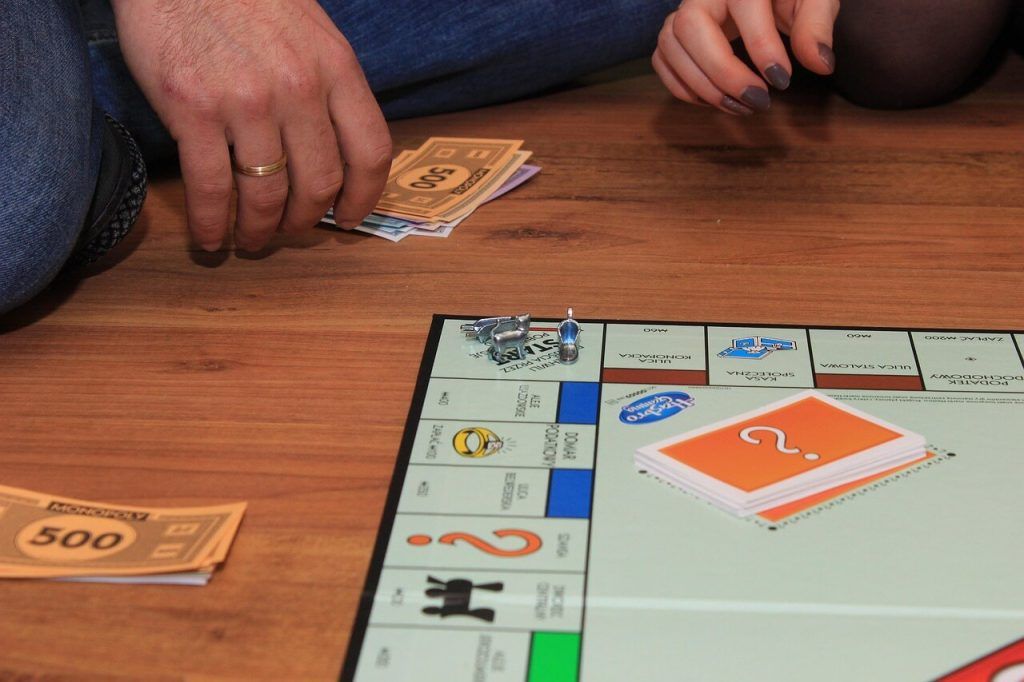
For instance, play Monopoly with your kid and ask them to divide the money among all players. Start with an easy example. Have them distribute $100 to 4 players. Gradually introduce more complex problems by having them divide $250 among the same 4 players. As you’re having family fun while studying, your kid won’t even realize when they’ve become a division master.
#11 Teaching division for kids by cooking
Cooking together with your child is an easy way to practice division while having fun as a family. You might be surprised to figure out that most kids really enjoy cooking and are quite good at it. The benefit of being able to eat the final product further stimulates them to do all necessary multiplications, divisions, and other mathematical operations to complete the recipe.
In practical terms, you can take a recipe and change the proportions. For example, divide all ingredients by 2 if you’re cooking just for yourselves. Multiply by 3 if you’re inviting friends over. After a few dozen cookies and cupcakes, you’ll have not only a little chef but also a little math master.
#12 How to learn division with visualization
Finally, the key to success with any strategy for learning how to divide is to learn how to visualize the dividend, divisor, and quotient. For beginners, division is a very hypothetical concept with no real meaning in life. Not all kids are born mathematicians, and it can be really hard for them to perform even simple math operations.
When introducing division, use visual manipulatives to demonstrate how vision works in practice. For instance, get 9 pencils and distribute them equally between your child, your spouse, and yourself. That’s an easy way to visualize division with the simple tools you have at home.
The top 3 difficulties of teaching division
- Being unable to visualize division
- Failing to understand the relationship between multiplication and division
- Missing steps in long division
Being unable to visualize division
One of the most common struggles I’ve seen among children learning how to divide is not being able to see division. Meanwhile, visualization is key to how to explain division and the logic behind it.
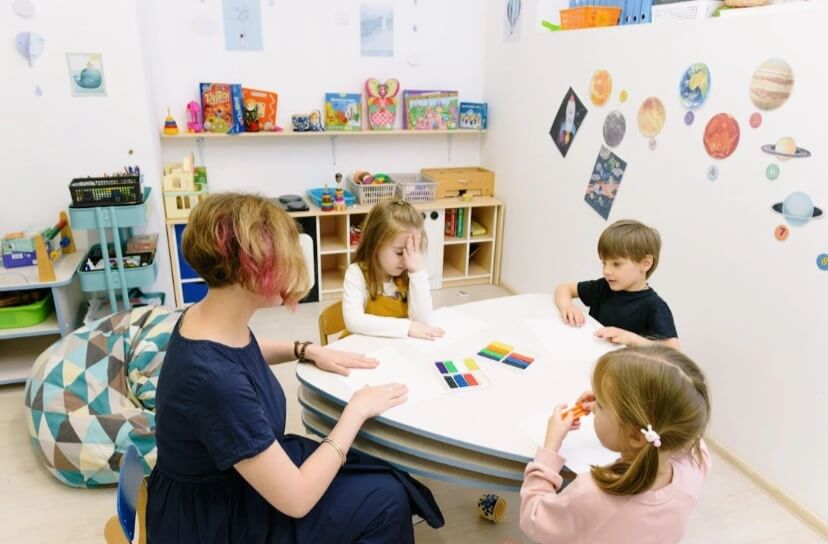
One of the best ways to overcome this challenge is to use visual aids to demonstrate the concept of dividing numbers. If your child is still small, simply take a few physical objects, such as toys, and organize them into groups of equal shares to demonstrate division.
If your kid is already older, you can incorporate number lines, diagrams, and area models for the visualization of division.
Failing to understand the relationship between multiplication and division
Something else that disrupts the proper learning of division for many children is being unable to see the connection between multiplying and dividing numbers. To prevent this problem, clearly explain to your child how division is simply the opposite of multiplication. You can use objects like balls to multiply them and then divide them to show how numbers transform in the two math operations.
Additionally, make sure that your child knows the multiplication tables well before jumping into division. Otherwise, things will get really messy really quickly.
Missing steps in long division
A third common mistake when learning division is to forget steps in long division. That happens quite often because of the many actions that go into the process.
The best way to prevent this is to teach your child a mnemonic to remember the exact order of operations and to show them how to concentrate. Explain to them how important it is to check the final answer via multiplication to assure accuracy.
Conclusion: Teaching kids division with Brighterly
These are the 12 best ways to teach division to children in different grades and with different learning styles. Still, they all aim to make the abstract concept of division tangible and related to the real world as well as fun. If you want to introduce dividing numbers to your small child, it’s recommended to use songs and games. If your kid is already older, try using multiplication and teaching all relevant vocabulary.
And if you want to help your precious one learn division in no time and stress-free, check out Brighterly tutoring.
With the Brighterly math program, you get:
✅ Individualized learning plan and materials
✅ Top-notch math tutors
✅ Free division worksheets to develop skills outside classes
With Brighterly, you don’t have to commit before seeing the quality of teaching yourself. Book free math lesson today to turn your child into a math wizard tomorrow.



